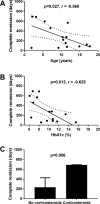Complete remission in children and adolescents with type 1 diabetes mellitus-prevalence and factors
- PMID: 37100887
- PMCID: PMC10133219
- DOI: 10.1038/s41598-023-34037-7
Complete remission in children and adolescents with type 1 diabetes mellitus-prevalence and factors
Abstract
Little is known about complete remission in Type 1 diabetes mellitus (T1D) with the discontinuance of insulin treatment for a period of time. In this retrospective study we analysed the frequency and factors of onset and duration of 1. remission and 2. complete remission in children and adolescents with T1D from the Children Diabetes Centre in Bratislava, Slovakia. A total of 529 individuals with T1D, aged < 19 years (8.5 ± 4.3 years) at diabetes onset were included in the study. Remission was defined by HbA1c < 7.0% (53 mmol/mol) and an insulin daily dose < 0.5 IU/kg (and 0 IU/kg for complete remission). Remission occurred in 210 (39.7%) participants, and 15 of them had complete remission (2.8% from all participants). We have identified a new independent factor of complete remission onset (higher C-peptide). Complete remitters had a longer duration of remission compared with other remitters and also differed in lower HbA1c levels. No association was seen with autoantibodies or genetic risk score for T1D. Thus, not only partial but also complete remission is influenced by factors pointing toward an early diagnosis of T1D, which is important for better patient outcome.
© 2023. The Author(s).
Conflict of interest statement
The authors declare no competing interests.
Figures

References
Publication types
MeSH terms
Substances
LinkOut - more resources
Full Text Sources
Medical

